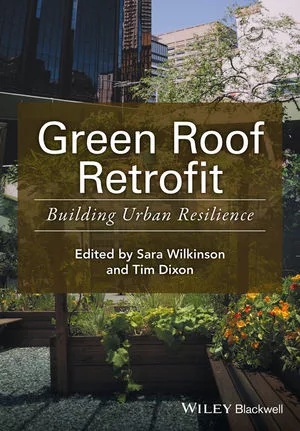Slate Journey
Unearthing Centuries of Beauty and Resilience
Roofing contractors from North America tour the birthplace of Welsh roofing, witnessing how slate continues covering remarkable and resilient rooftops throughout Europe
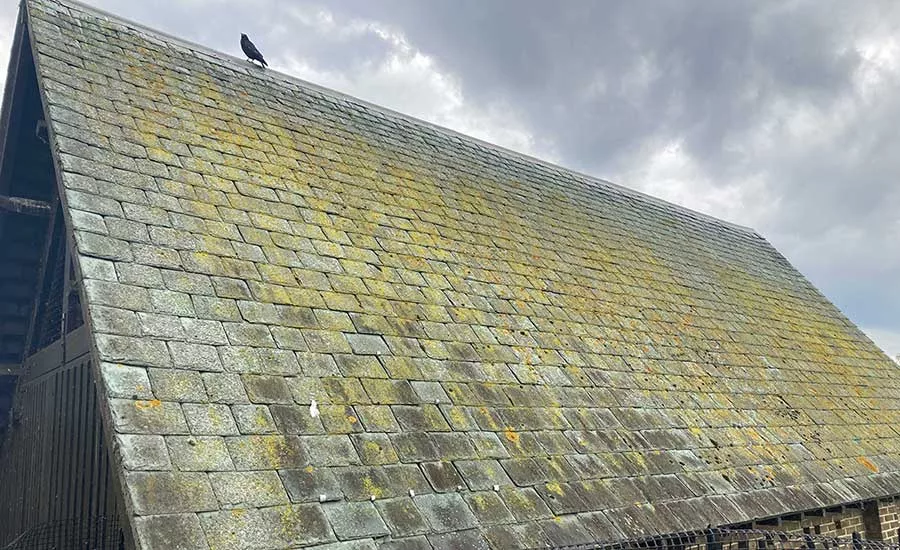
I love a good roofing adventure.
When my good friend Bob Pringle of Evans Roofing Company, located in Elmira, N.Y., called and invited me to join the leaders of the National Slate Association and Slate Roofing Contractors Association on a tour of slate quarries in Wales, I had to say, “of course.” Without any idea of what I was getting myself into, I knew enough that the unknown was a critical element of the adventure.
It turns out the tour, organized by Clay Heald of New England Slate, was designed to take a small group from the United Kingdom to Wales and then to Ireland on an adventure of learning — the likes of which defies comparison.
This dispatch summarizes the people and places we visited, what we learned about the U.K.’s roofing industry, the use of slate in Wales, and the remarkable and resilient slate-roofed buildings of Dublin.
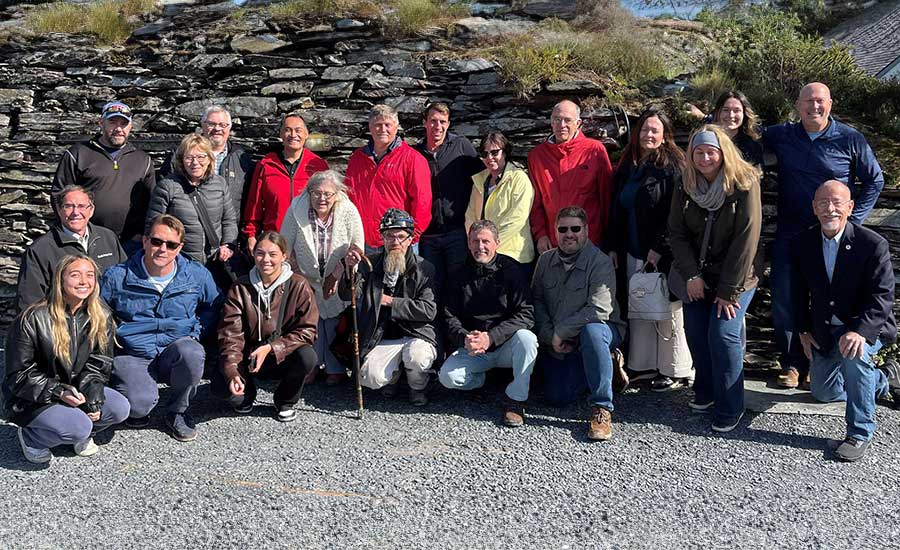
A group made up of National Slate Association and Slate Roofing Contractors Association members headed to the U.K. and then Ireland to learn more about slate and its origins.
London Calling
We started in London, taking advantage of an invitation to join the National Federation of Roofing Contractors for its 2023 U.K. Roofing Awards banquet. NFRC lays claim to being the largest and most influential roofing trade association in the U.K., promoting quality contractors and quality products.
While we have many competitions for roofing projects in the U.S., we have nothing compared to the high-energy production of the NFRC’s U.K. Roofing Awards. The event showcased roofing and cladding projects in dozens of categories. The grand finale, the “Roof of the Year” award, was taken home by Stuart Wheeler Roofing for a beautiful residential slate roofing project in Thurlestone, a small village in South Devon, England.
We were able to meet a number of the roofing contractors receiving awards as well as U.K. industry dignitaries. I met Matt Downs, an editor who has also been a fixture in the U.K.’s roofing and cladding industry for years. (It was good to exchange a handshake after years of occasional emails finally.)
Matt was kind enough to share his reporting on the awards in his publication, Total Contractor. Perhaps one of the most striking differences in this awards ceremony was the inclusion of the roofers, who mounted the stage with their company leaders to be acknowledged and accept the awards for their excellent work. Elevating all tradespeople this way is a lesson we would do well to learn domestically.
Also attending the U.K. Roofing Awards were leaders of the International Federation of the Roofing Trade, or IFD, known in the U.S. for its affiliation with the National Roofing Contractors Association. Like the NFRC, the IFD’s goal is to advance the interests of the roofing industry within Europe.
The IFD likewise hosts an annual event showcasing roofing projects and a world championship where young roofers compete within the framework of vocational training in the skilled trades.
Hopefully, as the U.S. advances roofing skills training in career and technical schools, we can send our national champions to the world championship. The seed of connection was first sewn in 2019 when the Durable Slate Company became the first U.S. company to win a metal roofing project award from the IFD for its Steeple Square project in Dubuque, Iowa. (Durable’s COO, Gary Howes, and John Chan, Durable owner, were with the group for this tour.)
We spent our remaining time in London taking in the sights, most of which were buildings clad with slate roofing. For example, did you know Westminster Abbey’s steep-pitched roof is covered using Westmorland Green slate? Westmorland Green, quarried in England, is produced by England’s sole remaining slate quarry, Honister Slate.
I am also happily able to dispel the myths surrounding English cuisine. The meals we enjoyed — from the NFRC banquet to countless pubs and restaurants we visited — were all quite good, and the beer was indeed cold.

Slate is environmentally safe and lasts for nearly 70 years, with its colors derived from minerals and chemical compositions.
Wales: Quarry Time
The centerpiece of our slate tour adventure took place in Wales. We started with a visit to the Welsh Slate Penrhyn Quarry, one of the country’s oldest quarries. Our tour of the quarry, currently owned by the Breedon Group, was led by Michael Halle, whose decades of experience in the slate roofing industry provided substantive depth in helping us understand its role in the Welsh roofing industry.
Welsh Slate operates the Penrhyn Quarry as well as two nearby quarry sites: at Ffestiniog and Cwt-y-Bugail. Given the nature of stone as a roofing material, each quarry brings forth roofing slates that vary in color and characteristics.
Our tour included a trip to the "working quarry" as well as a demonstration of how the stone is cut and cleaved into one of three available thicknesses of roofing slate.
We also received an invite to tour the production facility where stone workers were busy executing the (mostly) manual process of taking slabs of stone, cleaving, and grading them into individual pieces before being placed into crates for shipping worldwide.
My direct "connection" to Penrhyn slate was the one slate project I furnished in my hometown of Jacksonville, Fla. The owners of a new home under construction on the river were so particular about the materials used for their Georgian mansion they sent their architect to Charleston, S.C., to find the “perfect” slate for its roof. My friend, Greg Hageman of Greg’s Roofing in Ormond Beach, Fla., performed the installation.
Most of the slate roofing professionals on the tour, which included quarriers, distributors, contractors, and consultants, were well familiar with all the Welsh Slates. Like me, for most of those on the tour, this was a first-time visit to the Welsh Slate quarries.
“I was fascinated by all the Penrhyn slate roofs early in my career in Charleston, S.C., after Hurricane Hugo [in 1989]; I even met some Welsh slaters there, so I’ve always had a fascination with the Penrhyn Quarry,” described John Chan, owner of the Durable State Co. “Being there and seeing the history of the quarry and the museum was spectacular for me as I’ve always viewed getting to Penrhyn as the Holy Grail of slate roofing.”
The slate quarry visit was highly educational, but the visits to Zip World and the Deep Mine Tour were amazing — an absolute blast. While none of us in the group signed up for the optional zipline over Penrhyn Quarry, we appreciated watching pairs of intrepid zippers taking on a nearly one-mile-long experience, listed as “…the fastest zipline in the world,” which claims participants can reach speeds up to 100 mph.
The other option, touring Penrhyn Castle, seemed the more attractive choice; we Yanks have ziplines in the U.S. but few castles. The tour was fantastic and framed through the story of how one man, Edward Douglas-Pennant, would take the Welsh slate industry to new heights on his way to becoming Baron Penrhyn — and accumulating significant wealth along the way.
While he built this castle, he did not establish Welsh slate mining and quarrying. His tenure as the steward of the Welsh slate industry was during the 19th century; Welsh slate extraction can trace its roots back hundreds of years to when the Romans first entered the area.
Speaking of traced back, we learned that much of the slate in this part of the world is 450 million years old. Don’t ask me about the science behind carbon dating, but we learned this metamorphic stone is unique and found in a variety of colors and qualities all over the world.
I will note that some of the most unique colors, and indeed some of the best quality stone, are quarried right here in North America.
A slate mine? Previously, I had always considered roofing slate as a “quarried” material, not “mined.” But, in fact, slate is extracted both ways, and the deep mine tour was another great learning experience.
We learned that mining slate in the early days was brutally hard, primarily manual labor. Transporting the material from below ground to the surface required mine operators to lay narrow-gauge rail lines throughout 25 miles of tunnels to bring the stone forth. From the mines, slate was moved to a port explicitly built for Welsh slate.
The mine, like many since-closed quarries throughout Wales and most of the U.K., has since been transformed into a tourist destination. Wales is replete with slate quarries that have long since been closed, including the Dinorwic Quarry, which is the location of the Welsh National Slate Museum.
The collection of artifacts held at the museum includes the old steam engines used to move slate from the mountains to the ports. We also learned how the stone was cut manually into individual shingles, as well as how slate ridge fixtures were made and used.
“Although somewhat sated by age, I was touched by the blood, sweat, tears, and rewards that went into mining slate at the Ffestiniog site,” said roof consultant Jeff Levine, a slate and copper roofing expert and associate principal with Wiss, Janney, Elstner Associates, Inc.
“All of which is captured in each slate shingle placed on the roof, and how far we have come since the 'old' days, and how far we still have to go,” Levine added.
A last item of interest I’ll share is when Welsh slate production was interrupted during a record-breaking strike, lasting from 1900 to 1903. The dispute centered on union rights, pay and working conditions. It was a bitter battle between Lord Penrhyn and the slate quarry workers, which subsequently ripped apart a community, changing this part of North Wales forever.
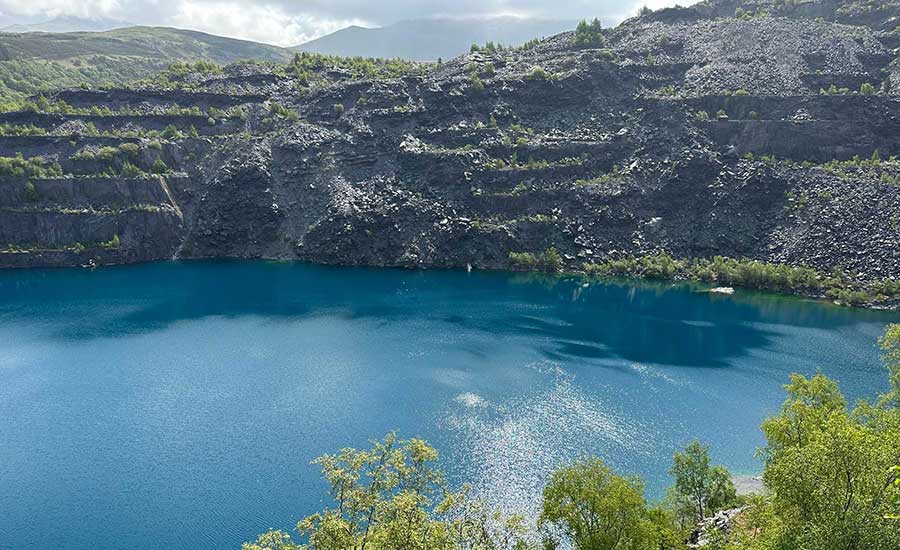
A view of one of the Welsh State slate quarries.
Ireland Bound
A relatively short ferry ride across calm seas took us from the north of Wales to Dublin, Ireland, for the last stop on our adventure. Of course, we felt obliged to make a requisite pilgrimage to have a proper pint of Guinness in the capital’s Temple Bar neighborhood, home to its bustling nightlife. (At least Bob and I obliged.)
Conducting our slate tour were representatives of Lagan Building Products, or LBS, led by Managing Director Peter Lagan and his associate, Martin. The highlight of the tour for me was the visit to St. Patrick’s Cathedral, which received a new slate roof two years prior.
A kiosk inside the sanctuary made the pitch for contributions to pay for the new roof. Like the slate mines and quarries of Wales, many historic cathedrals of Europe are both tourist destinations as much as houses of worship.
Our time in Ireland was too brief. Through one of my siblings performing one of those mail-in DNA tests, I discovered myself to be roughly half Irish — despite my Italian surname. It was rewarding to experience my newly discovered ancestral homeland and left longing to see the rest of the country.
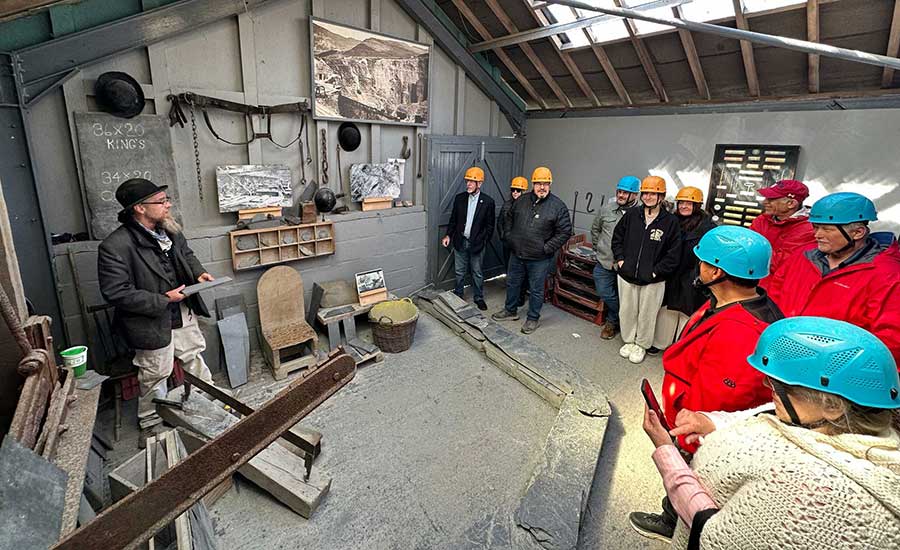
Slate stone is cut and cleaved into one of three available thicknesses of roofing slate, though the actual shapes of slate tiles can vary.
Some Final Thoughts
It is always good when you can learn a thing or two about the industry you work in, but it is a blessing to do it with a great group of professionals. Learning about slate was great, but getting to know my fellow travelers was the absolute best.
My interest in slate roofing goes back a long way, in spite of the fact that I grew up in Florida, a place with very little slate roofing; perhaps that is why I am so intrigued. Moving to Atlanta in the mid-1990s finally brought me into a slate-using market, and the company I worked for and later retired from had branches in Savannah, Ga., and Charleston, S.C., with many historic buildings clad with slate roofs.
Perhaps it’s the endurability of slate that is so appealing. There’s something about resilience that is admirable. Materials that possess a classic look and come with centuries of history are just exceptional. In my view, natural slate roofing takes its place on the top of the list of steep roofing systems due to its natural beauty and long history of durability.
Looking for a reprint of this article?
From high-res PDFs to custom plaques, order your copy today!




